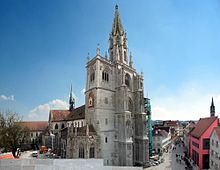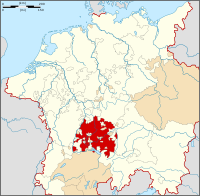- Bishopric of Constance
-
Prince-Bishopric of Constance
Hochstift KonstanzState of the Holy Roman Empire ← 
1155–1803  →
→Coat of arms
Capital Konstanz
Meersburg (from 1527)Government Theocracy Historical era Middle Ages
Early modern period- Missionary diocese
established585 - Prince-Bishopric 1155 - Council of Constance 1414–18 - Joined
Swabian Circle1500 - Mediatised to Baden 1803 - Diocese dissolved 1821 The Bishopric of Constance was a diocese of the Roman Catholic Church and ecclesiastical state of the Holy Roman Empire that existed from about 585 until 1821. Its seat was Konstanz at the western end of Lake Constance in the south-west corner of Germany. The diocese covered, in present-day borders, a large part of Switzerland, the largest part of Baden-Württemberg, and a small part of Austria.
The Diocese of Constance was founded in the late 6th century in the course of the christianization of the Alamanni tribes around Lake Constance and the High Rhine. About 585 the seat of the Bishop of Vindonissa in the Aargau was moved to the former Roman castrum of Constance. The Bishops of Constance originally were subordinate to the Archdiocese of Besançon, since 782 they were subordinate to the Archbishopric of Mainz. The area of the Constance diocese within the Duchy of Swabia stretched from the Gotthard Pass in the south to the Stuttgart region in the north, then the largest of the Holy Roman Empire.
From the 12th century until 1803 the Prince-Bishopric of Constance was an ecclesiastical Imperial State, confirmed by Emperor Frederick I Barbarossa in a 1155 deed, though its territory was diminuished with the rise of the Swiss Confederacy and the House of Habsburg. During the Early Middle Ages the bishops were also the political ruler of Konstanz, however towards the end of the 12th century their power was reduced to a small zone around the Cathedral as Konstanz made efforts to gain the status of a Free imperial city. Numerous bishops hence fell into conflict with the citizens and in 1527, during the Protestant Reformation, the administrative seat of the Prince-Bishop was finally moved to nearby Meersburg. However Konstanz fell to the Counter-Reformation induced by the Habsburgs, who finally incorporated the city into their Further Austrian possessions in 1548.
In the course of the German Mediatisation in 1803, the Prince-Bishopric was dissolved as a state and became part of the Margraviate of Baden. The diocese was finally dissolved by Pope Pius VII in 1821, after disobedient Vicar general Ignaz Heinrich von Wessenberg had been elected diocesan administrator upon the death of the last bishop Karl Theodor von Dalberg in 1817. While Wessenberg was supported by the government of the Grand Duchy of Baden, the Pope never recognized his election. The Pope disagreed with Wessenberg's liberal views, and by a bull of 16 August 1821 dissolved the diocese in order to prevent Wessenberg from becoming bishop. The area of the diocese in Baden became part of the newly established Roman Catholic Archdiocese of Freiburg in 1827 and the Swiss lands fell to the Diocese of Basel, whereas the cantons of Obwalden and Nidwalden, parts of Uri, Glarus and Zürich are provisorily administrated by the Diocese of Chur up to today.
Famous bishops
- Solomon I (835-871)
- Gebhard I von Wetterau, von Tegerfelden (873-875)
- Solomon II (875-889)
- Solomon III (890-919)
- Conrad I (934-975)
- St Gebhard (979-995)
- Gebhard III (1084-c.1106)
- Konrad von Tegerfelden (1208-1233)
- Hugo von Hohenlandenberg (1496-1532)
- Johann von Lupfen (1532-1537)
- Johann von Weeze (1537-1548)
- Christoph Metzler (1549-1561)
- Mark Sittich von Hohenems (1561-1589)
- Andreas von Österreich (1589-1600)
- Johann Georg von Hallwyl (1601-1604)
- Jakob Fugger (1604-1626)
- Werner von Praßberg (1626-1627)
- Johann von Waldburg (1627-1639)
- Johann Franz I. von Praßberg und Altensummerau (1645-1689)
- Marquard Rudolf von Rodt (1689-1704)
- Johann Franz Schenk von Stauffenberg (1704-1740)
- Hugo Damian von Schönborn (1740-1743)
- Kasimir Anton von Sickingen (1743-1750)
- Franz Konrad von Rodt (1750-1775)
- Maximilian Christof von Rodt (1775-1799)
- Karl Theodor von Dahlberg (1799-1817)
See also
External links
- de:Liste der Bischöfe von Konstanz - complete list of bishops
Catholic League (1609–35) within the  Holy Roman Empire
Holy Roman Empire Categories:
Categories:- Former theocracies
- Former countries in Europe
- States of the Holy Roman Empire
- States and territories established in 1155
- States and territories disestablished in 1803
- States and territories established in 585
- 580s establishments
- Dioceses established in the 6th century
- Roman Catholic dioceses in the Holy Roman Empire
- Roman Catholic dioceses in Switzerland
- Former Roman Catholic dioceses in Germany
- 1821 disestablishments
- Lists of Swiss people
Wikimedia Foundation. 2010.



